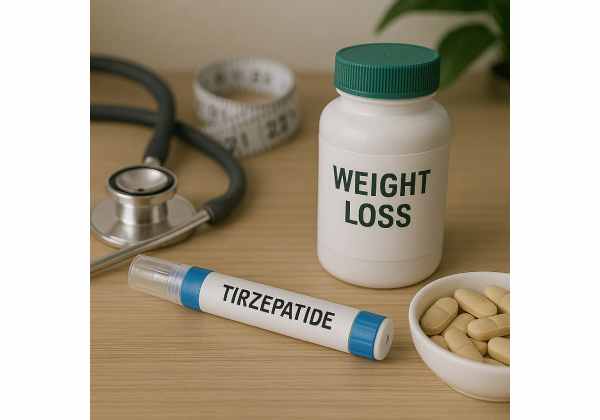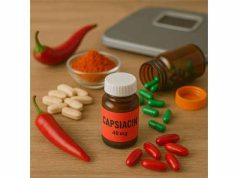
Tirzepatide is a once-weekly injection that targets two gut-hormone pathways (GIP and GLP-1) to calm appetite, slow stomach emptying, and improve blood sugar. For many people, it unlocks steady, double-digit weight loss when paired with protein-forward meals, fiber, and basic movement. This guide translates the science into practical steps: how tirzepatide works, what results to expect at each dose, how to minimize side effects, and when to consider alternatives. If you are comparing all your options—from nutrition tools to prescription therapies—start with our overview of medical options for weight management to see where tirzepatide fits and when it makes sense to use it.
Table of Contents
- What is tirzepatide and does it work?
- How to start tirzepatide: dosing and titration
- Results timeline and expectations
- Side effects and troubleshooting
- Safety, who should avoid and interactions
- Evidence and outcomes summary
- Long-term plan, cost and alternatives
- Frequently Asked Questions
What is tirzepatide and does it work?
Tirzepatide (Mounjaro® for type 2 diabetes; Zepbound® for chronic weight management) is a dual GIP/GLP-1 receptor agonist. Those hormones help your brain and digestive system regulate hunger, satiety, and insulin. By amplifying their signals, tirzepatide:
- Quiets appetite and food preoccupation. People describe fewer intrusive thoughts about food and an easier time stopping at comfortable fullness.
- Slows gastric emptying. Meals leave the stomach more gradually, so fullness lasts longer.
- Improves glycemic control. Insulin works more effectively, and post-meal spikes are lower. This helps curb energy crashes that drive grazing.
How it translates into weight loss
Weight changes because daily calories drop without constant willpower battles. Most patients find portions shrink, snacking fades, and sugary drinks lose appeal. Over weeks and months, those small changes compound into meaningful fat loss, especially around the waist.
What “meaningful” looks like
- With a structured plan, many people see 5% weight loss by 3 months, 10–15% by 6–12 months, and higher in responders. Individual results vary; adherence and dose matter.
- Health markers—A1C, triglycerides, blood pressure, liver fat—often improve alongside the scale.
Who tends to benefit most
- Adults with BMI ≥30, or BMI ≥27 with weight-related conditions (e.g., prediabetes, hypertension, sleep apnea).
- People who struggle with evening overeating or high-calorie beverages and want a calmer appetite to make meal planning stick.
- Those willing to follow a stepwise dose schedule and attend regular check-ins.
Where tirzepatide fits in the bigger picture
Medication widens the runway for behavior change; it does not replace it. You’ll still get the best results from protein-anchored meals, fiber, sleep, and resistance training. If you need a quick refresher on building that base, read our fundamentals on safe weight-loss habits before or alongside medication.
Bottom line: Tirzepatide works by reducing drive to eat and stabilizing blood sugar, making calorie control sustainable. Expect steady—not instant—loss that compounds over months when paired with simple, repeatable routines.
How to start tirzepatide: dosing and titration
Tirzepatide is injected once weekly, any time of day, with or without food. You increase the dose gradually to balance effectiveness with tolerability.
Typical titration (confirm your exact plan with your prescriber)
- Start: 2.5 mg once weekly for 4 weeks (this “primer” dose readies your gut; weight loss may be modest here).
- Step up: 5 mg for 4 weeks.
- Further steps as needed: 7.5 → 10 → 12.5 → 15 mg, with at least 4 weeks at each step to assess side effects and appetite control.
- Finding your dose: Many settle between 7.5 and 12.5 mg; some need 15 mg. Higher is not always better—the “lowest effective dose” is the goal.
Injection tips that reduce side effects
- Choose one weekday and set a reminder; consistency helps.
- Inject into abdomen, thigh, or upper arm; rotate sites.
- Store pens refrigerated per label; most can be kept at room temperature for a limited time—check your box for the exact window.
- If you miss a dose, many labels allow up to 4 days late; otherwise skip and resume on your usual day (confirm specific rules for your product).
Food strategy during titration
- Keep meals small to moderate, chew slowly, and pause halfway to gauge fullness.
- Anchor plates with 25–35 g protein and high-fiber sides to keep GI symptoms low and satiety high.
- Limit greasy or very large meals while your dose increases.
Baseline and follow-up
- Vitals: blood pressure, heart rate, weight, and waist.
- Labs: A1C/fasting glucose (if relevant), renal function, and lipids per your clinician.
- Medications: If you use insulin or sulfonylureas, your prescriber may lower those doses to prevent hypoglycemia as intake drops.
- Checkpoints: At about 12 weeks, evaluate percent weight change and side effects; adjust dose or strategy if progress stalls.
Lifestyle moves that compound results
- Protein before carbs at meals to smooth glucose.
- Soluble fiber (beans, oats, psyllium) to ease constipation and improve fullness; details in our guide to soluble fiber options.
- Strength training 2–3×/week to preserve lean mass.
- Sleep 7–8 hours; poor sleep drives hunger and blunts loss.
Travel and routine changes
- Pens are portable; keep them cool and out of direct light.
- If you must shift your injection day, move it gradually by a day each week to avoid large gaps.
Results timeline and expectations
Weeks 1–4: Getting used to it
Appetite often softens within the first week, but the 2.5 mg starter is mainly for tolerance. Expect smaller portions, slower eating, and a learning curve with fullness cues. Nausea is usually mild if you keep meals modest and avoid rich foods.
Weeks 5–8: First clear changes
At 5–7.5 mg, many notice consistent portion reduction and fewer snacks, especially in the evening. Weekly weight averages may drop 0.5–1.0% of body weight, with normal day-to-day noise from hydration, sodium, and menstrual cycles.
Week 12: Decision point
- If you are down ≥5%, you are on track—continue the plan.
- If progress is <3–5%, review dose, meal size, drinks, and sleep; step the dose if tolerated.
- If side effects dominate, slow the titration or hold the dose longer.
Months 3–6: Compounding benefits
Appetite feels predictable; restaurant portions become manageable with less effort. Many reach 8–12% loss by this window if they adhere to protein and fiber targets and keep liquid calories low. Improvements show up in A1C, triglycerides, blood pressure, and waist.
Months 6–12: Consolidation or further loss
Some continue to 15%+ loss; others stabilize. Stability is a win—maintaining a healthier weight and cardiometabolic profile matters more than chasing the last kilogram.
What success looks like (beyond the scale)
- Waist down by several centimeters (visceral fat is metabolically important).
- Fewer cravings and overeating episodes; food decisions feel quieter.
- Better sleep and energy; walking and stairs feel easier.
Common reasons progress stalls and how to fix them
- Liquid calories crept back: audit coffee drinks, alcohol, juices, and “healthy” smoothies.
- Protein slipped: return to 25–35 g per meal; consider a shake on busy mornings (see our guide to protein shakes for weight management).
- Weekend swings: plan two default breakfasts/lunches for weekends; use a pre-meal protein mini-shake before events.
- Dose too low for you: discuss a step up if side effects are mild but hunger still pushes intake high.
Realistic expectations
- Tirzepatide makes eating easier to regulate, not effortless. You will still choose meals, plan groceries, and protect sleep.
- Occasional nausea days happen; scale back meal size and hydration, then resume your usual pattern.
Side effects and troubleshooting
Most side effects are gastrointestinal and dose-dependent. A slow titration plus simple meal hygiene prevents most issues.
Common effects and quick fixes
- Nausea or early fullness: eat smaller portions, pause mid-meal, avoid high-fat/fried foods; ginger tea or peppermint can help. Keep sparkling water or broth on hand.
- Diarrhea: scale back greasy foods; favor bananas, rice, toast, and cooked veggies for a day; hydrate with electrolytes if needed.
- Constipation: raise soluble fiber (beans, oats, psyllium), drink more water, and walk daily; consider magnesium citrate at night if your clinician agrees.
- Bloating/reflux: smaller meals; avoid lying down soon after eating; limit carbonation during titration.
- Injection-site redness or itch: rotate sites; let the pen warm to room temp briefly before injecting.
Less common, important signals
- Gallbladder symptoms: upper right abdominal pain, fever, or jaundice—seek care. Rapid weight loss can increase gallstone risk.
- Pancreatitis warning: severe, persistent abdominal pain (often radiating to the back) with vomiting—stop the drug and get urgent evaluation.
- Dehydration/acute kidney stress: persistent vomiting or diarrhea can reduce kidney perfusion; hydrate and contact your clinician early.
- Hypoglycemia: mainly a concern if you use insulin or sulfonylureas; watch for shakiness, sweating, confusion—treat per your diabetes plan and alert your team.
Before dental work, procedures, or anesthesia
Tirzepatide may delay gastric emptying. Tell your surgical team you use a weekly incretin therapy; they may adjust fasting instructions or recommend holding a dose before anesthesia per local protocol.
Oral medicines and birth control
Because gastric emptying slows, absorption of some oral drugs can shift. In particular, combined oral contraceptives may be less reliably absorbed during initiation and dose increases; many clinicians advise a barrier method for 4 weeks after starting and 4 weeks after each dose step. Consider non-oral contraception if avoidance of pregnancy is critical.
If side effects persist
- Hold at your current dose for an extra 4 weeks before stepping up.
- Consider a dose reduction if quality of life suffers; a moderately effective, tolerable dose beats a higher dose you cannot sustain.
- Re-audit meals: rich sauces, large portions, and alcohol are frequent triggers.
For fiber dosing and product choices that pair well with incretin medications, see our comparison of soluble fiber options.
Safety, who should avoid and interactions
Do not use tirzepatide if you have:
- Personal/family history of medullary thyroid carcinoma (MTC) or MEN2.
- Severe allergy to tirzepatide or its components.
- Pregnancy or are actively trying to conceive (weight-loss drugs are not used during pregnancy). Discuss timing if planning pregnancy.
Use caution and close supervision if you have:
- History of pancreatitis, gallstones, or gallbladder disease.
- Gastroparesis or significant GI motility disorders.
- Renal impairment—mainly if vomiting/dehydration occurs.
- Diabetic retinopathy (rapid A1C improvement can transiently shift symptoms; schedule eye care).
- Eating disorders—weight-focused medications may complicate recovery.
Medication interactions and adjustments
- Insulin or sulfonylureas: dosing often needs down-titration to reduce hypoglycemia risk as intake and A1C improve.
- Oral contraceptives: consider backup contraception during initiation and dose steps (see Section 4).
- Oral drugs with narrow therapeutic windows: monitor levels or effects when you change dose (due to delayed gastric emptying).
Alcohol and stimulants
- Alcohol increases nausea and can complicate glycemic control; keep it modest and avoid during dose increases.
- If you use caffeine or pre-workouts, keep them to the morning to protect sleep—appetite is quietest when well-rested. For stimulant safety, see our guide to caffeine dosing and timing.
Fertility, pregnancy, and breastfeeding
- Discuss a washout period before trying to conceive.
- Do not use for weight loss during pregnancy or breastfeeding unless specifically advised for another indication.
Monitoring checklist
- Every visit: weight trend, waist, blood pressure, heart rate, side-effect review.
- Periodically: A1C/glucose (if relevant), lipids, and renal function, especially after GI losses.
- Behavioral anchors: protein grams/day, fiber intake, sleep hours, step counts.
Red-flag symptoms—seek care promptly
- Severe abdominal pain (with or without vomiting)
- Persistent vomiting or inability to keep fluids down
- Signs of gallbladder infection (fever, right-upper-quadrant pain)
- Sudden vision changes
For class-level comparisons and when a different incretin agent might suit you better, skim our overview of GLP-1 medications for weight loss.
Evidence and outcomes summary
Why tirzepatide stands out
Tirzepatide’s dual action (GIP + GLP-1) generally produces greater average weight loss than older, single-pathway GLP-1 agonists at comparable time points in head-to-head or cross-trial comparisons. People often report a stronger sense of “I’m done” at meals and fewer cravings between them.
Key outcomes typically tracked in clinic
- Percent weight loss: the most meaningful single metric (e.g., 5%, 10%, 15%).
- Waist circumference: a window into visceral fat change; reductions often outpace scale movement early on.
- Glycemic control: A1C and time-in-range improve in those with diabetes or prediabetes.
- Lipids and blood pressure: triglycerides fall and BP eases modestly as weight drops.
- Liver enzymes and fat: improved ALT and ultrasound/MRI signs in metabolic fatty liver.
Durability and maintenance
- Continued use generally maintains or extends loss while the dose remains stable.
- Stopping abruptly tends to rebound some weight as appetite signals return. If you plan to stop, build maintenance habits (protein, fiber, activity, sleep) and consider a gradual dose step-down with nutrition support.
Body composition
Paired with protein (≈1.2–1.6 g/kg/day) and resistance training, tirzepatide preferentially reduces fat mass while preserving lean mass as much as possible for a medication-assisted cut.
Limitations to keep in mind
- Response varies; genetics, baseline appetite, and lifestyle matter.
- GI side effects are the trade-off for appetite control; most ease with time and dose pacing.
- No medication replaces environment design (meal prep, snack boundaries, sleep).
How it compares with other options
- Versus metformin: far stronger for weight loss; metformin remains useful for insulin resistance with modest effect. See metformin and weight loss.
- Versus phentermine-topiramate: different side-effect profile; stimulants can be unsuitable for some.
- Versus bariatric surgery: surgery remains most effective for severe obesity; see our overview of sleeve vs bypass for when to consider it.
Practical takeaway
Tirzepatide offers high-impact, behavior-enabling appetite control. Pair it with simple, repeatable nutrition and movement to turn pharmacology into durable change.
Long-term plan, cost and alternatives
How long do people stay on tirzepatide?
- Many continue beyond 12 months if benefits and tolerability persist. Long-term use is reasonable when weight, metabolic health, and quality of life improve and side effects remain manageable.
Cost and access basics
- Coverage varies by indication (diabetes vs weight management), insurer, and region.
- Clinics may require documentation of BMI criteria, prior lifestyle attempts, and regular follow-up.
- If cost is high, discuss dose optimization, manufacturer programs, or alternative agents.
When to switch, pause, or stop
- Insufficient response: <3–5% loss after adequate titration and adherence—consider switching within the class or to a different mechanism.
- Side effects dominate at needed doses despite pacing and diet changes—step down or exit.
- Life changes (pregnancy planning, new conditions) may prompt a pause with a maintenance plan in place.
Evidence-based alternatives
- Other GLP-1 RAs for those who do not tolerate dual-agonist therapy but like the mechanism.
- Naltrexone-bupropion if reward-driven eating is dominant. See our guide to naltrexone-bupropion.
- Phentermine-topiramate for structured appetite control without injections. See combination details.
- Orlistat for a non-systemic option paired with low-fat dietary patterns. See orlistat meal strategies.
- Bariatric surgery for severe obesity or when medical therapy is insufficient (durable, greatest average loss).
Maintenance playbook (with or without medication)
- Protein: ~1.2–1.6 g/kg/day; aim for 25–35 g per meal.
- Fiber: 25–35 g/day from beans, vegetables, fruit, oats, and barley.
- Strength: 2–3 sessions/week; protect muscle, bone, and resting metabolism.
- Steps: build a daily baseline you can keep (e.g., 6–10k).
- Sleep: 7–8 hours; appetite is quieter when rested.
- Alcohol: modest; it adds calories and worsens nausea.
Mindset for the long game
Think in 12-week blocks: set habits, review results, adjust dose or tools, repeat. When medication is the right lever, use it. When life says “pause,” fall back on habits and resume if needed.
Frequently Asked Questions
How much weight do people typically lose on tirzepatide?
Many reach 10–15% loss over 6–12 months with a stepwise dose, protein-forward meals, fiber, and basic movement. Some exceed that; others lose less. Hitting ≥5% by about 12 weeks at a stable dose predicts better long-term results.
What is the dosing schedule for tirzepatide?
Most start at 2.5 mg weekly for 4 weeks, then increase by 2.5 mg every 4 weeks (5 → 7.5 → 10 → 12.5 → 15 mg) until appetite is controlled without burdensome side effects. Your prescriber will tailor the pace and stop where benefits and tolerance meet.
What side effects should I expect first?
Early effects are usually nausea, early fullness, diarrhea or constipation, and occasional reflux. These ease with smaller meals, less fat, more fiber and fluids, and dose pacing. Seek care for severe abdominal pain, persistent vomiting, or signs of gallbladder trouble.
Can I take tirzepatide if I am on birth control pills?
Tirzepatide slows stomach emptying, which can reduce absorption of combined oral contraceptives, especially when starting or increasing dose. Use a barrier method for about 4 weeks after initiation and after each dose step, or consider non-oral contraception.
What happens if I stop tirzepatide?
Appetite typically rebounds and some weight returns. If you plan to stop, first build maintenance habits (protein, fiber, steps, sleep) and talk with your clinician about a gradual step-down. Resume therapy if regain outpaces your plan.
Is alcohol safe while using tirzepatide?
Small amounts are usually tolerated, but alcohol can worsen nausea and add calories. Keep it modest, avoid drinking during dose increases, and skip alcohol on days you feel queasy or dehydrated.
How do Mounjaro and Zepbound differ?
Both contain tirzepatide. Mounjaro is approved for type 2 diabetes; Zepbound is approved for chronic weight management. Doses and pens are similar; coverage rules may differ. Your clinician will choose based on your diagnosis and insurance.
References
- ZEPBOUND® (tirzepatide) Injection, for subcutaneous use 2025
- Tirzepatide Once Weekly for the Treatment of Obesity 2022 (RCT)
- Tirzepatide after intensive lifestyle intervention in adults with overweight or obesity: the SURMOUNT-3 phase 3 trial 2023 (RCT)
- Continued Treatment With Tirzepatide for Maintenance of Weight Reduction in Adults With Obesity: The SURMOUNT-4 Randomized Clinical Trial 2024 (RCT)
- AGA Clinical Practice Guideline on Pharmacological Interventions for Adults With Obesity 2022 (Guideline)
Disclaimer
This guide is for general education and does not replace personalized medical advice, diagnosis, or treatment. Always speak with a qualified health professional before starting, stopping, or changing medications or supplements, altering doses, or making major diet and exercise changes—especially if you have chronic conditions, take prescription drugs, are pregnant, or are planning pregnancy.
If this article clarified your options, please share it with someone weighing medication choices. For practical updates and new guides, follow us on the social platform you already use—Facebook, X, Instagram, or LinkedIn.










